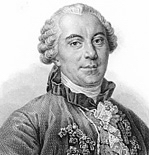 Georges Louis Leclerc, Comte de Buffon was the French naturalist perhaps most responsible for the rise of European interest in natural history during the eighteenth century.
Georges Louis Leclerc, Comte de Buffon was the French naturalist perhaps most responsible for the rise of European interest in natural history during the eighteenth century.
His massive Histoire naturelle (36 volumes) set out to organize all that was then known about the natural world. He was the source of important ideas about the distribution of plants and animals around the globe, relationships among species, the age of the earth, the sources of biological variation, and the possibility of evolution.
The numerous illustrations to Buffon’s volumes, which began publication in 1749, became the source of information about the visual appearance of creatures that inhabited every continent. He argued for an energetic and graceful style in scientific writing, thereby making his work accessible to a wide audience in Europe and beyond.
He was forced to leave university after becoming involved in a duel, and set off on a grand tour of Europe, returning when his father’s remarriage threatened his inheritance.
He first made his mark in the field of mathematics and in Sur le jeu de franc-carreau introduced differential and integral calculus into probability theory. During this period he corresponded with the Swiss mathematician, Gabriel Cramer.
Buffon’s encyclopedic and empirical method influenced the gathering of knowledge in numerous fields. His translations of works by Isaac Newton and Stephen Hales’ Vegetable staticks into French also heightened his interest in biology.He organized one of the first experiments to prove that lightning was electrical, basing his metallic lightning rod directly on the work of Benjamin Franklin. Buffon’s mind was capacious, expansive and synthetic. He defined his study as broadly as possible:
Natural history embraces all the objects the universe presents to us. This prodigious multitude of quadrupeds, birds, fish, insects, plants, minerals, etc., offers to the curiosity of the human mind a vast spectacle, of which the whole is so great that the details are inexhaustible.
Buffon resisted the detailed taxonomic classifications of Linnaeus, arguing instead for a natural history that was dynamic and inclusive. While less accurate than more technical researchers, Buffon’s approach allowed him to see patterns and systems where others had seen only discrete details.
As Director of the Jardin du Roi in Paris, he became the model of the scientific collector, analyzing living, dead, and fossilized organisms in an effort to understand their anatomy, reproduction, classification, and distribution. He transformed the king’s garden into a scientifically significant museum and research center. His work made it clear that species were not the same the world over, that the planet was much older than the Biblical account suggested (Buffon thought tens of thousands of years), and that plant and animal species were biologically related in complex ways.
Buffon was succeeded in his post at the Jardin du Roi by the Count de Lacepede, who did research on electricity and published The Natural History of Oviparous Quadrupeds and Serpents in 1788, the year Buffon died. Buffon’s son was soon to be guillotined by revolutionary forces in France, but Buffon’s massive work survived to influence natural historians in Europe and America for over a century.
He died in Paris.
Major Works of Comte de Buffon
– Histoire naturelle (36 volumes)

Its fantastic as your other posts : D, thankyou for putting up. “I catnap now and then, but I think while I nap, so it’s not a waste of time.” by Martha Stewart.